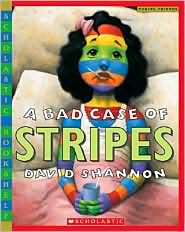"She had no idea what to wear with those crazy stripes."
 |
| barnesandnoble.com |
Citation
Shannon, D. (1998). A bad case of the stripes. New York: Scholastic Inc.
Summary
Camilla Cream is very concerned with what other people think of her. She loves lima beans, but no one else does, so she pretends to hate them. When her skin suddenly becomes rainbow-striped on the first day of school, she doesn't know what to do. Her doctor cannot figure out what's wrong with her, so he sends her to school, where her skin changes colors and patterns as her classmates laugh and shout out different ideas. The Specialists and Experts don't know what to do and the TV news has even become interested. Finally, a little old shows up at the Cream household with a new rememdy: a handful of lima beans. Could the lima beans be the key to bringing back the real Camilla Cream?
My Impressions
Richly colorful paintings and creative text make A Bad Case of the Stripes an excellent book to teach children the importance of being themselves. Shannon's imaginative illustrations show the humor of Camilla's affliction, as her skin goes from bright stripes to a myriad of patterns to sprouting plants and fuzzy viruses until she "becomes one with the room," featuring windows for eyes and a bed for lips. Children will giggle as they see how Camilla changes and her family tries everything to figure out what's going on.
Richly colorful paintings and creative text make A Bad Case of the Stripes an excellent book to teach children the importance of being themselves. Shannon's imaginative illustrations show the humor of Camilla's affliction, as her skin goes from bright stripes to a myriad of patterns to sprouting plants and fuzzy viruses until she "becomes one with the room," featuring windows for eyes and a bed for lips. Children will giggle as they see how Camilla changes and her family tries everything to figure out what's going on.
Reviews
Camilla Cream wants to fit in, so she conforms, denying
herself the things she craves--lima beans, for example--if the other kids frown
upon them. She wakes up one morning covered head to toe with party-colored
stripes--not the state of affairs aspired to by a conventionalist, but it's
only the beginning of her troubles. Her schoolmates call out designs and
Camilla's skin reacts: polka dots, the American flag--"poor Camilla was
changing faster than you could change channels on a T.V." Specialists are
called in, as are experts, healers, herbalists, and gums. An environmental
therapist suggests she "breathe deeply, and become one with your
room." Camilla melts into the wall. It takes a little old lady with a
handful of lima beans to set Camilla to rights. Shannon's story is a good poke
in the eye of conformity--imaginative, vibrant, and at times good and
spooky--and his emphatic, vivid artwork keeps perfect pace with the tale.
[Review of the book A bad case of the stripes by D. Shannon]. (1997, December 15). Kirkus Reviews. Retrieved from http://www.kirkusreviews.com.
Camilla, who loves lima beans but won't eat them because
it's not cool, finds that deferring to others isn't all it's cracked up to be.
In fact, her desire to please and be popular causes her some spectacular
problems: she suddenly breaks out in stripes, then stars, then turns "purple
polka-dotty" at the behest of a delighted classmate. Her weird mutations,
which stymie doctors and send the media into a frenzy, become more and more
extreme until she finally blends into the walls of her room--her lips the
red-blanketed mattress on her bed, her eyes the paintings on the wall. Will she
never be herself again? Shannon's over-the-top art is sensational, an ingenious
combination of the concrete and the fantastic that delivers more than enough
punch to make up for the somewhat heavy hand behind the story, and as usual,
his wonderfully stereotypic characters are unforgettable. The pictures are
probably enough to attract young browsers (Camilla in brilliant stripped glory
graces the jacket), and the book's irony and wealth of detail may even interest
readers in higher grades.
Zvirin, S. (1998, January 1). [Review of the book A bad case of the stripes by D. Shannon]. Booklist, 94(9). Retrieved from EBSCOhost.
Suggested Library Uses
- Read as part of a family storytime. Best if the children are at least 5 years old. Have each family member paint or draw a self-portrait expressing what is unique or special about him- or herself. Family members can help each other come up with qualities or traits.
- Include in a display about differences, being yourself, or self-confidence.
Notes
Buckaroo Book Award, 2001, 2nd Runner Up (Grades K-3, Wyoming)
Buckaroo Book Award, 2001, 2nd Runner Up (Grades K-3, Wyoming)
Find it @ your library - Albany County Library
E PB S
